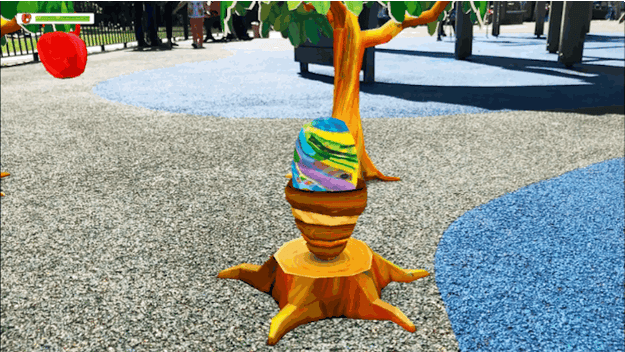
In a matter of hours, the world will be buzzing with talk of augmented reality. The technology, which places digital elements on top of the real world, has long been a clunky, hobbyist passion. But that’s about to change. In recent months, Apple and Google have released technology frameworks that do much of the heavy lifting for AR developers, helping them create applications they never could before. And tomorrow, the public will get a good look at the true scope of what these frameworks can help produce when Apple pulls the curtain back on the final version of iOS 11, and the first set of apps built with its ARKit framework along with it.
Though many AR developers are keeping their work under wraps until Apple’s big reveal, a small but fascinating Twitter account called @madewithARKit has been sharing a preview of what’s on tap. The account, which curates videos from still-unreleased AR apps, has featured a steady stream of intriguing AR use cases. One app it’s highlighted transforms your driveway into a virtual Tesla showroom, another turns your phone screen into an accurate tape measure, and one more lets you arrange virtual furniture in your living room to see how it would look in real life.
“It’s got all the makings of a platform shift.”
The excitement building in anticipation of these apps’ release harkens back to the early days of the iOS App Store, when Apple debuted a platform that developers quickly used to distribute their apps to hundreds of millions of people. It took some time for these developers to push out applications that changed the way people lived their daily lives, and some started out silly — fart apps and other goofy things. But the App Store eventually became a key channel through which major apps like Uber, WhatsApp, and Snapchat reached the masses. And similar hopes exist for ARKIt and Google’s rival, ARCore.
“It’s got all the makings of a platform shift,” David Urbina, who is building an augmented reality app called Neon using ARKit, told BuzzFeed News. “Apple is essentially turning a light switch on.”
@ARKitweekly / Twitter / Via Twitter: @ARKitweekly
Neon has a number of features that layer the digital world on top of the real one, including a friend locator that uses your phone’s camera display to place arrows above contacts within 100 meters. Before ARKit, Neon could only accurately locate your contacts if you stood still, so if you took a few steps, you’d need to refresh the app. With ARKit — which offers lighting-fast image processing and measurement capabilities that allow a phone to understand where it is in space — Neon gives you a consistently accurate read, so the app is actually useful now.
Applications like Neon were hardly feasible when the term “augmented reality” was coined by a Boeing researcher in 1990, and would’ve been a pain to use just a few months ago, but the technology is now finally capable of supporting them. “To truly, credibly represent virtual objects in the world, it requires a lot of puzzle pieces to come into place that are technically challenging,” Jon Wiley, director of immersive design at Google, told BuzzFeed News. Those puzzle pieces include powerful processors and accurate image-recognition technology, Wiley said, both of which are now advanced enough to the point where AR can be unleashed.
Fire-breathing dragon in your backyard, built with ARCore
YouTube / Via youtube.com
We've seen glimpses of AR's potential before — in Pokémon Go and in Microsoft's HoloLens demos — but this moment marks AR is coming to public at scale, a major milestone. “Three to five years from now, we’ll look back at this time as an inflection point,” Todd Richmond, director of the Mixed Reality Lab at the University of Southern California, told BuzzFeed News. “This is really taking AR to the masses.”
“Three to five years from now, we’ll look back at this time as an inflection point.”
Apple has been stoking expectations for ARKit. “We actually have hundreds of millions of iPhones and iPads that are going to be capable of AR,” Apple's senior vice president of software engineering Craig Federighi said when introducing ARKit at the company’s Worldwide Developers Conference earlier this year. “That’s going to make overnight ARKit the largest AR platform in the world.”
But the key test of this technology is whether it can be used to develop applications that change the way we interact with our devices or the way we do things in daily life. Technology industry experts BuzzFeed News spoke with for this story struggled to name an AR use case that might transform a common behavior in the way that, say, Uber transformed transportation. But both Google and Apple appear willing to take a wait-and-see approach, putting the tools in the hands of developers and waiting for what happens next. Asked to name use cases that display the power of AR, Wiley compared it to the personal computer. “That’s a little like saying — what are PCs good for? They’re really good for spreadsheets, that's true. But they've also completely transformed everything else we do in the world.”
What’s clear is that ARKit and ARCore will pave the way for apps that never would’ve seen the light of day before. Both provide developers with the ability to create augmented reality apps that work as you move up, down, right, left, forward, and backward — otherwise known as the six degrees of freedom. And developers are finding ways to make use of this technology — even if the applications are novel at first.
Game developer Ridgeline Labs, for instance, began building a pet dog game for virtual reality last fall, not even considering AR due to the technical challenges. At the time, it was impossible for the company to make a digital dog to walk around with you in augmented reality, or jump on your couch, or walk around your furniture, aware of where it was. But after Apple introduced ARKit, that all changed, and the team is now on track to release an AR app this fall in which the dog does all those things.
@madewithARKit / Twitter / Via Twitter: @madewithARKit
“It just wouldn’t exist without ARKit,” Ridgeline Labs cofounder Jeremy Slavitz told BuzzFeed News, of his app. “You couldn’t really walk around a dog, or pet a dog if it weren’t in ARKit. It just wouldn’t know where you were moving, there’s no way.”
Along with gaming, retail will likely be one of the first industries to embrace AR. Ikea, for instance, is expected to debut a new app called Ikea Place that will allow its users to place “true to-scale” Ikea furniture inside their homes using AR, potentially saving them hours inside the furniture giant that can turn agonizing for many.
With both Apple and Google in the game, developers are starting to become more interested in an AR world that feels ripe with possibilities and has a big potential market. Their enthusiasm could quickly lead to a major surge in AR apps, including those designed with a daily use case in mind, not just novel experiences like a virtual pet dog.
Urbina is thinking about how to get Neon used every day, and is planning to include a feature where people can leave digital messages for friends on top of the physical world along his friend finder tool. It will be people like Urbina, with more permanent uses in mind, that determine the future of the technology — the only question is what that will be. “There’s only so many times you’ll be able to anchor a piece of furniture or a cartoon in the room before you get tired of that,” he said. “The leaders in AR are going to have to establish a level of persistence in order to move past the novelty.”
Quelle: <a href="Why Augmented Reality Is About Take Over Your World“>BuzzFeed

Published by